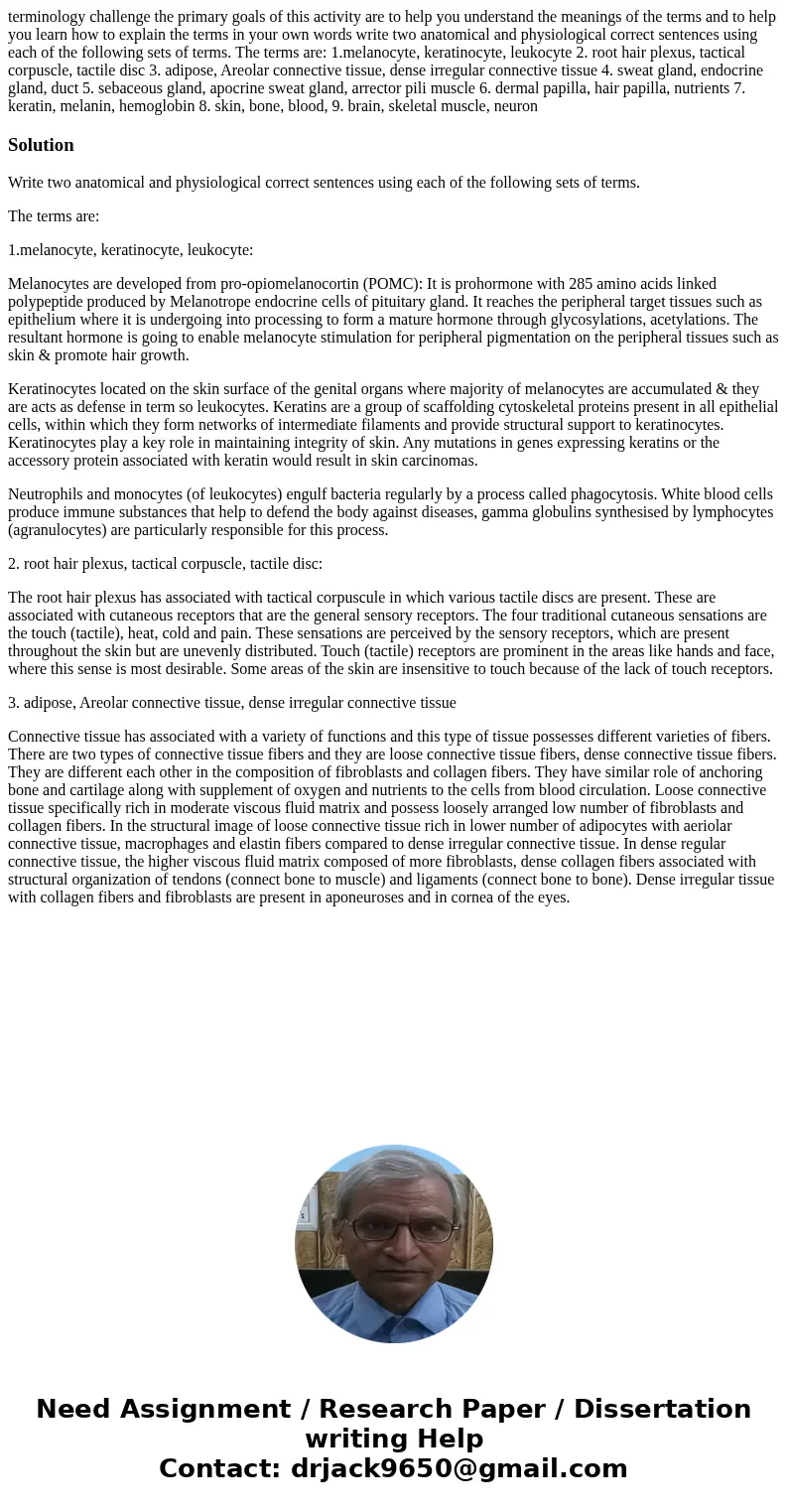terminology challenge the primary goals of this activity are
terminology challenge the primary goals of this activity are to help you understand the meanings of the terms and to help you learn how to explain the terms in your own words write two anatomical and physiological correct sentences using each of the following sets of terms. The terms are: 1.melanocyte, keratinocyte, leukocyte 2. root hair plexus, tactical corpuscle, tactile disc 3. adipose, Areolar connective tissue, dense irregular connective tissue 4. sweat gland, endocrine gland, duct 5. sebaceous gland, apocrine sweat gland, arrector pili muscle 6. dermal papilla, hair papilla, nutrients 7. keratin, melanin, hemoglobin 8. skin, bone, blood, 9. brain, skeletal muscle, neuron
Solution
Write two anatomical and physiological correct sentences using each of the following sets of terms.
The terms are:
1.melanocyte, keratinocyte, leukocyte:
Melanocytes are developed from pro-opiomelanocortin (POMC): It is prohormone with 285 amino acids linked polypeptide produced by Melanotrope endocrine cells of pituitary gland. It reaches the peripheral target tissues such as epithelium where it is undergoing into processing to form a mature hormone through glycosylations, acetylations. The resultant hormone is going to enable melanocyte stimulation for peripheral pigmentation on the peripheral tissues such as skin & promote hair growth.
Keratinocytes located on the skin surface of the genital organs where majority of melanocytes are accumulated & they are acts as defense in term so leukocytes. Keratins are a group of scaffolding cytoskeletal proteins present in all epithelial cells, within which they form networks of intermediate filaments and provide structural support to keratinocytes. Keratinocytes play a key role in maintaining integrity of skin. Any mutations in genes expressing keratins or the accessory protein associated with keratin would result in skin carcinomas.
Neutrophils and monocytes (of leukocytes) engulf bacteria regularly by a process called phagocytosis. White blood cells produce immune substances that help to defend the body against diseases, gamma globulins synthesised by lymphocytes (agranulocytes) are particularly responsible for this process.
2. root hair plexus, tactical corpuscle, tactile disc:
The root hair plexus has associated with tactical corpuscule in which various tactile discs are present. These are associated with cutaneous receptors that are the general sensory receptors. The four traditional cutaneous sensations are the touch (tactile), heat, cold and pain. These sensations are perceived by the sensory receptors, which are present throughout the skin but are unevenly distributed. Touch (tactile) receptors are prominent in the areas like hands and face, where this sense is most desirable. Some areas of the skin are insensitive to touch because of the lack of touch receptors.
3. adipose, Areolar connective tissue, dense irregular connective tissue
Connective tissue has associated with a variety of functions and this type of tissue possesses different varieties of fibers. There are two types of connective tissue fibers and they are loose connective tissue fibers, dense connective tissue fibers. They are different each other in the composition of fibroblasts and collagen fibers. They have similar role of anchoring bone and cartilage along with supplement of oxygen and nutrients to the cells from blood circulation. Loose connective tissue specifically rich in moderate viscous fluid matrix and possess loosely arranged low number of fibroblasts and collagen fibers. In the structural image of loose connective tissue rich in lower number of adipocytes with aeriolar connective tissue, macrophages and elastin fibers compared to dense irregular connective tissue. In dense regular connective tissue, the higher viscous fluid matrix composed of more fibroblasts, dense collagen fibers associated with structural organization of tendons (connect bone to muscle) and ligaments (connect bone to bone). Dense irregular tissue with collagen fibers and fibroblasts are present in aponeuroses and in cornea of the eyes.

 Homework Sourse
Homework Sourse